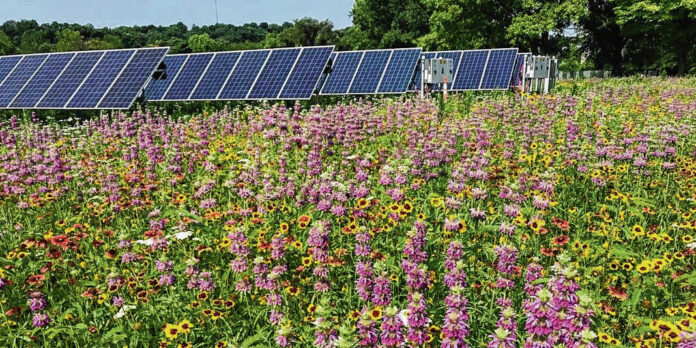Regulations expected to make Bartholomew County more solar energy friendly are being recommended by the Bartholomew County Plan Commission.
By a vote of 6-1, commission members agreed with a motion from member Arnold Haskell that a solar field, which the commission calls Commercial Solar Energy Systems (CSES), should be set back 200-feet from residential lots of 5 acres or less. Earlier drafts established it at 500 feet.
Property owner Mark Niemoeller said there was no factual basis for a 500-foot setback, adding the state is trying to encourage the use of solar power statewide as one of many forms of energy.
Commission members also agreed on a provision updated from last month’s meeting that no structures, equipment, storage areas, vehicle service drives or fence be allowed within 250 feet of several forms of residential developments. That was lowered from an initially suggested setback of 500 feet.
It also calls for a 500-foot setback from schools, day-care centers, hospitals, retirement centers and other community facilities until a waiver is obtained between the two parties.
Another revision states that no solar energy system electrical substation will be allowed within 500 feet of residential properties, which had been earlier established at 750 feet.
Following a four-hour meeting Wednesday attended by about 50 people at Columbus City Hall, the plan commission voted to recommend proposed amendments that will be sent to the Bartholomew County commissioners for final approval. The commissioners are expected to conduct at least one public hearing on the recommendations.
If approved by the county commissioners, the proposed amendments would be used as a starting point by the Bartholomew County Board of Zoning Appeals whenever they consider a variance for a proposed solar field. A public hearing is required of every solar field request brought to the BZA, Columbus/Bartholomew County Planning Director Jeff Bergman said.
Of those who addressed the plan commission Wednesday, 10 spoke in favor of lowering an earlier recommendation of a 500-foot setback for homes with smaller lots, or to express their support of local solar energy.
That’s the same number who requested 700-foot setbacks. Opponents expressed their concern that having a neighboring solar field would have a negative impact on their property values and/or be aesthetically unpleasing. While many insist they support alternative forms of energy, they say they are against placing solar fields on farmland. Instead, they want the solar fields in a urban brownfield or on non-agricultural land in need of redevelopment.
An additional three speakers provided information without expressing an opinion on the subject.
One of the comments came from Columbus real estate broker Jeff Hilycord, who said an industry survey claiming that solar farms don’t lower neighboring property values had too few participants to be accurate.
Instead, Hilycord cited three university studies that he said has a larger number of properties surveyed. One was a University of Rhode Island study claiming a solar field can cause property within a mile to decline 1.7%. The second was a University of Birmingham study claiming a 5.4% drop for homes within a half-mile, and a University of North Carolina study claiming a drop of 8.7% for residences within one mile of a solar field.
But Hilycord’s figures generated little discussion from plan commission members.
After the public hearing, the commission decided not to add in an amendment that calls for buffering the solar field for aesthetic purposes. Members including Jorge Morales pointed out that natural buffers such as trees or shrubs take several years to become functional as a buffer. It was finally decided that details regarding buffers should be worked out between property owners, their neighbors or with the solar field developer.
Contract language calls for a third-party engineer to make an independent assessment of the decommissioning value of the solar fields every five years, Indianapolis attorney Mary Soladae said. Although she recommended that salvage costs should be included in the amendment, commission members did not agree.
But they did have a consensus that complete decommissioning will be required regardless of the presence of a financial guarantee. That includes any instance where a financial guarantee is insufficient for the complete removal of equipment that has outlived its usefulness, a revised amendment stated.
Other recent amendments call for solar arrays to not exceed 20 feet in height when oriented at maximum tilt, and shall provide a minimum clearance of 3 feet between the ground and the solar panel. Advocates say the clearance is needed for the purpose of vegetative ground cover, which is expected to serve as a deterrent to soil erosion.
Topographic maps will also be required before construction – and again during decommissioning – in order to ensure the surface grade is restored to its pre-construction conditions, another revision stated.





